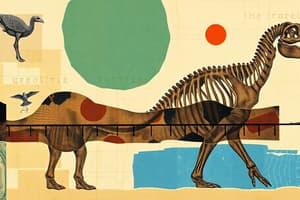Podcast
Questions and Answers
The largest sections of the geological time scale are called ______.
The largest sections of the geological time scale are called ______.
eons
The eons are divided into ______.
The eons are divided into ______.
eras
The Archean era lasted from 2500 million years ago to ______ million years ago.
The Archean era lasted from 2500 million years ago to ______ million years ago.
4600
Major changes in Earth's history mark the boundaries between the ______.
Major changes in Earth's history mark the boundaries between the ______.
The oldest rocks that we know were found in the Cryptozoic ______.
The oldest rocks that we know were found in the Cryptozoic ______.
The oldest rocks were formed in the ______ era.
The oldest rocks were formed in the ______ era.
The Mesozoic Era is popularly known as the Time of ______.
The Mesozoic Era is popularly known as the Time of ______.
The Paleozoic Era is divided into 6 periods, including the ______ period.
The Paleozoic Era is divided into 6 periods, including the ______ period.
During the Carboniferous Period, ______ and pteridophytes were formed.
During the Carboniferous Period, ______ and pteridophytes were formed.
The largest mass extinction happened in the ______ Period.
The largest mass extinction happened in the ______ Period.
Flashcards are hidden until you start studying
Study Notes
Geological Time Scale Overview
- Geological time scale documents life's history and geological events, established through rock layers and fossil studies.
- Radioactive dating assists in determining absolute time divisions.
Divisions of Time
- Eons are the largest time sections, divided into eras; eras are further divided into periods, then epochs.
Eons
- Two primary eons:
- Cryptozoic (Precambrian)
- Phanerozoic
- Each eon comprises three distinct eras.
Eras
- Major eras in Earth's history include:
- Archean: 4600 mya - 2500 mya
- Proterozoic: 2500 mya - 540 mya
- Paleozoic: 540 mya - 250 mya
- Mesozoic: 250 mya - 65.5 mya
- Cenozoic: 65.5 mya - present
- "Mya" stands for million years ago.
Cryptozoic Eon
- Spanned from 540 mya to 4600 mya; represents nearly 90% of Earth's history.
- Birth of simple organisms like bacteria, algae, and protozoa.
- Oldest known rocks emerged around 3.5 billion years ago.
- Comprised of two eras: Proterozoic and Archean.
Archean Era
- Occurred from 2500 mya to 4600 mya.
- Development of earliest plants (marine algae) and bacteria (3800 mya).
- Formation of oldest rocks around 3500 mya.
Proterozoic Era
- Lasted from 540 mya to 2500 mya.
- Dominated by marine invertebrates, with limited shell-bearing organisms.
- Marked by significant glaciations.
Phanerozoic Era
- Began 540 mya and continues today.
- Divided into three significant eras:
- Paleozoic: Early life
- Mesozoic: Middle life
- Cenozoic: Present life
Paleozoic Era
- Extended from 570 mya to 250 mya.
- Six periods: Permian, Carboniferous, Devonian, Silurian, Ordovician, Cambrian.
- Introduction of organisms with hard parts, including shells and exoskeletons.
- Evolved pteridophytes, amphibians, reptiles, fishes, and trilobites.
Mesozoic Era
- Lasted from 250 mya to 65 mya, referred to as the Age of Reptiles.
- Divided into three periods: Triassic, Jurassic, Cretaceous.
- Notable appearance of dinosaurs, mammals, and gymnosperms.
Cenozoic Era
- From 65 mya to present.
- Divided into Tertiary and Quaternary periods.
- Known for the rise of modern mammals, angiosperms, and humans.
Important Periods in Earth's History
- Carboniferous Period (360 mya - 300 mya): Significant for the emergence of reptiles and pteridophytes, and formation of coal from buried plant matter.
- Permian Period (300 mya - 250 mya): Characterized by the largest mass extinction, with 90% of marine and 78% of terrestrial life perishing, potentially due to climate change and volcanic activity.
- Jurassic Period: Notably important within the Mesozoic era, marked by the diversification of dinosaurs and other life forms.
Studying That Suits You
Use AI to generate personalized quizzes and flashcards to suit your learning preferences.




